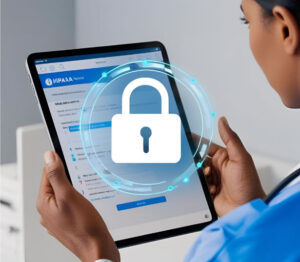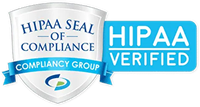In today’s healthcare landscape, safeguarding patient information is more critical than ever. The Health Insurance Portability and Accountability Act (HIPAA) was enacted to protect the confidentiality, integrity, and security of Protected Health Information (PHI). As electronic communication becomes the norm, ensuring that sensitive patient data shared via email remains secure is crucial for maintaining both legal compliance and trust.
Understanding HIPAA email encryption requirements is vital for healthcare providers, business associates, and any organization handling PHI. Non-compliance can result in substantial fines, legal repercussions, and damage to one’s reputation. This guide aims to clarify what HIPAA mandates regarding email security and how encryption plays a foundational role in meeting those standards.
Overview of HIPAA Compliance
HIPAA is a U.S. federal law enacted in 1996 with the core purpose of protecting the privacy and security of individuals’ health information. It establishes national standards to ensure that healthcare providers, health plans, and business partners responsibly manage PHI—whether stored electronically, spoken, or written.
The law is divided into several components, including the Privacy Rule, Security Rule, and Breach Notification Rule. The Security Rule requires explicitly covered entities and business associates to implement technical safeguards to protect electronic PHI (ePHI), such as access controls, audit controls, and encryption.
The overarching goal of HIPAA compliance is to establish a framework that protects sensitive health data from unauthorized access while making it available to authorized users when needed. While HIPAA does not specify exact encryption algorithms or methods, it mandates the implementation of appropriate security measures—including encryption—to ensure ePHI remains confidential and secure throughout its lifecycle.
Understanding HIPAA Email Encryption Requirements
HIPAA email encryption requirements focus on protecting ePHI transmitted through email—both during transit and when stored on servers or devices. While HIPAA does not explicitly mandate encryption in its written regulations, it strongly recommends its use to ensure compliance with the Security Rule’s confidentiality and integrity standards.
Encryption plays a critical role in achieving HIPAA compliance because it renders PHI unreadable to unauthorized parties if intercepted or accessed without proper authorization. When an email containing PHI is encrypted, it aligns with HIPAA’s principle of “reasonable and appropriate” safeguards designed to prevent data breaches.
HIPAA standards emphasize that covered entities should implement encryption methods that are consistent with recognized standards, such as Advanced Encryption Standard (AES). The goal is to protect PHI during transmission across public or unsecured networks and when stored on servers or devices susceptible to theft or hacking. Proper encryption measures reduce the risk of unauthorized access, helping organizations meet both HIPAA’s confidentiality requirements and breach prevention obligations.
The Significance of Email Encryption Under HIPAA
Email encryption is a cornerstone of HIPAA compliance because email remains a primary method for transmitting PHI—protected health information—between healthcare providers, payers, patients, and business associates. Without encryption, any PHI sent via email is vulnerable during transit; cybercriminals, hackers, or malicious insiders could intercept unencrypted messages, leading to unauthorized disclosures.
The risks of transmitting unencrypted PHI are significant. Data breaches involving health information not only violate HIPAA’s Privacy and Security Rules but can also result in severe financial penalties, legal actions, and loss of public trust. For instance, a breach could expose sensitive health records, leading to identity theft, fraud, or discrimination against patients. Such incidents often attract media scrutiny and erode patient confidence in the provider’s ability to safeguard their data.
Failure to adhere to HIPAA email encryption requirements can result in severe consequences. The Department of Health and Human Services (HHS) Office for Civil Rights (OCR) enforces HIPAA compliance and has issued substantial fines to organizations that failed to implement reasonable safeguards. These fines can range from thousands to millions of dollars, depending on the severity and duration of the breach, as well as the implementation of corrective action plans, reputational damage, and potential criminal charges in egregious cases. Moreover, non-compliance can invite lawsuits from affected patients and result in lengthy legal battles.
In summary, email encryption is not just a recommended best practice—it’s a legal obligation under HIPAA to protect confidential patient information and avoid costly penalties and legal repercussions.
End-to-End Encryption for HIPAA Compliance
End-to-End Encryption (E2EE) is a highly secure method of email encryption that guarantees only the sender and recipient can read the message content. Unlike standard encryption, which protects data in transit (such as TLS), E2EE ensures the email is encrypted on the sender’s device and remains encrypted until it’s decrypted on the recipient’s device, with no intermediate points of decryption involved.
In the context of HIPAA, E2EE addresses critical safeguards for ensuring confidentiality and controlling access to sensitive information. By encrypting PHI at the source and decrypting it solely on the intended recipient’s device, E2EE minimizes the risk of unauthorized access during transmission—protecting PHI from hacking, interception, or eavesdropping by malicious actors or cybercriminals. This aligns with HIPAA’s requirement that organizations implement “reasonable and appropriate” safeguards to protect electronic protected health information (ePHI).
Furthermore, because E2EE prevents intermediaries—including email service providers or network operators—from accessing the unencrypted message, it provides a higher level of security and compliance assurance. For healthcare providers, adopting E2EE solutions demonstrates a proactive approach to HIPAA’s confidentiality mandates, reducing breach risk and supporting compliance audits.
In essence, E2EE not only safeguards the content of PHI but also reinforces trust with patients and partners by ensuring that sensitive health data remains private from sender to recipient—making it an essential component of a HIPAA-compliant email strategy.
Implementing HIPAA-Compliant Email Encryption
Implementing HIPAA-compliant email encryption requires a structured approach. Here are actionable steps for healthcare organizations:
- Assessing Current Email Systems for HIPAA Compliance
- Conduct a Security Audit: Review your existing email infrastructure to identify vulnerabilities, including whether emails containing PHI are currently encrypted and how data is transmitted and stored.
- Identify Gaps: Determine if current email services support encryption, secure storage, and access controls aligned with HIPAA standards.
- Review Vendor Agreements: Ensure that your email service providers and third-party vendors have HIPAA Business Associate Agreements (BAAs) in place, guaranteeing they uphold HIPAA security measures.
- Selecting and Deploying HIPAA-Compliant Email Encryption Solutions
- Choose a Certified Solution: Select encryption products or services validated for HIPAA compliance, such as secure email platforms with built-in encryption, or third-party encryption tools approved for health data.
- Integrate Seamlessly: Deploy solutions that integrate with your existing email clients (Outlook, Gmail, etc.) without disrupting workflows. Ensure the solution encrypts PHI at rest and in transit.
- Implement Authentication & Access Controls: Use multi-factor authentication and role-based access to prevent unauthorized email access.
- Perform Pilot Testing: Before full deployment, test encrypted email exchanges with select users to identify issues and ensure smooth operation.
- Educating Staff on the Secure Use of Email for Transmitting PHI
- Conduct Regular Training: Educate all users about HIPAA requirements, the organization’s encryption policies, and best practices for secure email use.
- Develop Clear Policies: Document procedures for encrypting sensitive emails, including how to verify recipient encryption support and securely share decryption keys or passwords.
- Promote Security Awareness: Encourage staff to recognize phishing attempts, avoid sending PHI via unsecured email, and report suspicious activity.
- Ongoing Updates: Keep training current with evolving best practices and technology changes, and review policies periodically.
Challenges and Best Practices
Common Challenges:
- Technical Complexity: Implementing and managing encryption solutions can be complex, especially if staff lack technical expertise.
- User Resistance: Some users may find encryption procedures cumbersome or may forget to encrypt PHI, leading to potential non-compliance.
- Compatibility Issues: Different email clients and devices might not support the chosen encryption standards uniformly.
- Cost Constraints: Budget limitations can restrict access to enterprise-grade encryption solutions or BAAs with providers.
Best Practices for Overcoming These Challenges:
- Regular Audits and Monitoring: Conduct periodic reviews of email security controls, encryption effectiveness, and compliance status. Use audit logs to identify non-compliant activities.
- Vendor Vetting: Select reputable encryption providers with proven compliance records, strong customer support, and seamless integration with your existing systems.
- Staff Training & Engagement: Provide ongoing education emphasizing the importance of encryption, illustrating how it protects patient data, and simplifying encryption procedures as much as possible.
- Policy Enforcement: Establish clear organizational policies around secure email practices, including when and how to encrypt PHI and procedures for securely sharing decryption credentials.
- Automation & Integration: Use solutions that automate encryption tasks where possible, minimizing user error and administrative burden.
- Build a Culture of Security: Foster an environment where security best practices are viewed as integral to daily operations, encouraging staff buy-in and continuous improvement.
By addressing these challenges through strategic planning and ongoing education, healthcare organizations can significantly enhance their HIPAA compliance efforts and effectively protect patient privacy.
Email Encryption Solutions and Their HIPAA Compliance
When selecting an email encryption solution for HIPAA compliance, it’s essential to evaluate features such as security standards, ease of use, integration capabilities, and vendor compliance assurances. Here’s a review of several popular options:
- Microsoft Information Protection & Office 365 Message Encryption (OME)
- Features: Native integration with Microsoft 365; supports S/MIME, Office Message Encryption, and Azure Information Protection. Users can encrypt emails, restrict access, and add digital signatures.
- HIPAA Alignment: Microsoft offers BAAs for eligible enterprise plans, and their encryption solutions support HIPAA confidentiality requirements.
- Pros: Seamless integration for organizations already using Microsoft Office, easy to deploy, and consistent user experience.
- Cons: Advanced features may require licensing upgrades; some configurations can be complex.
- Paubox Secure Email
- Features: Cloud-based email encryption that enables sending and receiving secure emails directly from native email clients like Outlook and Gmail without needing recipient-side plugins.
- HIPAA Alignment: Certified HIPAA-compliant with BAAs, providing automatic encryption for inbound and outbound emails, including attachments.
- Pros: User-friendly, no decryption passwords needed for recipients, fast deployment.
- Cons: Subscription costs, cloud dependency.
- ProtonMail (End-to-End Encryption)
- Features: End-to-end encrypted email service with built-in encryption for messages and attachments, using public-key cryptography.
- HIPAA Alignment: While ProtonMail itself offers encryption, compliance depends on how it’s implemented within organizational policies; a BAA may be necessary, and some configurations may be needed.
- Pros: User privacy-centric, straightforward for end-users, free and paid plans.
- Cons: Less integration with existing enterprise email systems; mainly designed as a standalone secure email platform.
- Virtru
- Features: Protects email content with optional end-to-end encryption, supports DLP policies, and integrates with Gmail, Outlook, and others.
- HIPAA Alignment: Offers HIPAA-compliant solutions with BAAs, suitable for organizations needing secure, controlled sharing.
- Pros: Easy to deploy, firm control over content, and audit logs.
- Cons: Requires licensing; some features may add complexity.
- .lit (formerly Zix)
- Features: Enterprise-grade encryption, DLP, and email archiving solutions tailored for HIPAA compliance.
- HIPAA Alignment: Extensive compliance certifications and BAAs. Supports managed encryption workflows.
- Pros: Highly scalable, enterprise features, ongoing compliance support.
- Cons: Costly for small practices, broader enterprise focus.
Guidance on Selecting a Solution for Healthcare Providers
When choosing an email encryption solution that aligns with HIPAA requirements, consider the following:
- Compliance Certifications & BAAs: Ensure the provider offers a Business Associate Agreement (BAA) confirming HIPAA compliance.
- Encryption Standards: Confirm the solution supports industry-recognized standards (e.g., AES-256, TLS 1.2/1.3, S/MIME, or end-to-end encryption).
- Ease of Use: Select solutions that integrate seamlessly into existing workflows to promote user adoption and reduce errors.
- Integration & Compatibility: Compatibility with your existing email platform (e.g., Outlook, Gmail, enterprise email servers) is critical.
- Automatic & Transparent Encryption: Solutions that automatically encrypt email content and attachments reduce reliance on user action and improve compliance.
- Management & Auditing: The ability to monitor, audit, and manage encrypted communications is vital for HIPAA accountability.
- Cost & Support: Balance your budget against the solution’s features and vendor support services.
In summary, healthcare organizations should evaluate encryption solutions holistically, prioritizing compliance, usability, and scalability, to ensure they meet HIPAA standards and effectively protect patient data.
Maintaining Compliance: Monitoring and Updates
Maintaining HIPAA compliance is an ongoing process that requires continuous monitoring and proactive updates of your email encryption practices. As cybersecurity threats evolve and HIPAA regulations are periodically updated, healthcare organizations must ensure their security measures remain current and effective. Regular assessments help identify vulnerabilities, ensure encryption methods meet recognized standards, and verify that policies align with recent regulatory guidance.
Implementing a routine schedule for risk assessments is essential. These assessments should evaluate the effectiveness of existing encryption tools, review access controls, and identify any gaps in data protection strategies. Updating encryption technologies, such as adopting stronger algorithms or new secure communication platforms, is vital to stay ahead of emerging threats like sophisticated cyberattacks and data breaches.
Additionally, training staff on the latest security protocols and ensuring that encryption software and systems are correctly configured and maintained is crucial. Documenting compliance efforts, audits, and updates not only strengthens security posture but also helps demonstrate HIPAA adherence during audits or investigations. This dynamic approach—combining regular evaluation, technological upgrades, and staff education—serves as a robust foundation for HIPAA-compliant email security.
Final Thoughts
In today’s digital health environment, HIPAA email encryption requirements are not optional—they are essential for protecting patient PHI, ensuring confidentiality, and maintaining trust. Healthcare entities must implement encryption that safeguards data both in transit and at rest, ensuring this through ongoing monitoring, staff training, and regular system updates. Effective encryption practices uphold the core principles of confidentiality, integrity, and availability of health information as outlined in HIPAA.
The overarching goal of HIPAA remains clear: to protect patient privacy while enabling appropriate access to health data. Secure, encrypted email communication is a crucial component of this mission, particularly as cyber threats continue to evolve in sophistication. Organizations that prioritize and maintain strong encryption practices not only comply with legal standards but also uphold their commitment to patient trust and care.
Healthcare providers and their business associates are encouraged to conduct a comprehensive review of their current email encryption practices. Ensure that your systems are up-to-date, supported by HIPAA-compliant solutions, and integrated into your overall security framework. If you lack expertise or resources, seek advice from cybersecurity professionals with experience in healthcare data protection to optimize your encryption strategies and achieve complete compliance.
For further guidance, explore resources such as the Department of Health and Human Services (HHS) HIPAA Security Rule guidance, industry best practice guidelines, and industry-specific compliance tools. Staying vigilant and proactive in your encryption practices today will help safeguard your organization against tomorrow’s cyber threats and regulatory challenges.






